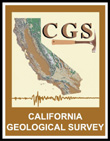
|
California Division of Mines and Geology
Special Report 106 Geologic Features—Death Valley, California |
Geologic Features of the Central Black Mountains, Death Valley, CaliforniaBR> James K. Otton1
1State University, University Park, Pennsylvania 16802.
INTRODUCTION
The Black Mountains, which form the eastern margin of the central part of Death Valley, California, contain complex lithologic and structural features that have been difficult to integrate with the geologic framework of the surrounding region. They are underlain mostly by a crystalline complex composed of folded pre-Cenozoic metasedimentary units, in part marble bearing, and of intrusive igneous rocks of Precambrian, Mesozoic(?), and Cenozoic age. Especially abundant in the complex is diorite that postdates the sediments, now metamorphosed, and predates other intrusive bodies that are more acidic and largely to wholly Cenozoic in age. Overlying the complex, generally with fault contact, are structural units composed variously of slightly metamorphosed Precambrian and Paleozoic sedimentary rocks and Cenozoic sedimentary and volcanic rocks. These constitute a relatively thin, discontinuous, and faulted cover of the complex.

|
| Low-altitude oblique aerial photograph of Copper Canyon turtleback in Black Mountains (see following paper). Floor of east side of Death Valley in foreground. Photo by Lauren A. Wright. |
The following is a report on the progress of a mapping project in the southwestern Black Mountains. The area (Fig. 1) includes the southwestern quarter of the Funeral Peak and the southeastern part of the Bennetts Well 15' quadrangles. In this area, the igneous and metamorphic complex—a dislocated cover of Cenozoic rocks—and two of the peculiar domical features known as turtlebacks are well exposed. Although many questions concerning the geologic history of the Black Mountains remain unanswered, the mapping to date has documented several features relevant to this history and the evolution of the region.
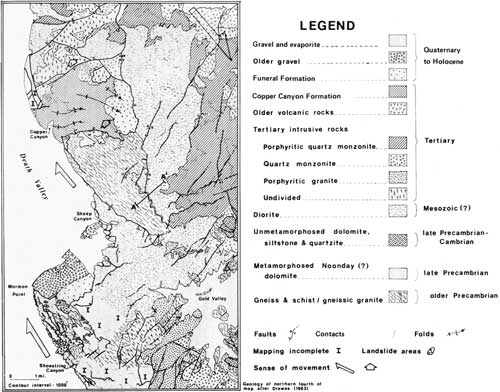
|
| Figure 1. Generalized geologic map, central Black Mountains, Death Valley, California. (click on image for a PDF version) |
The general geologic features of the Black Mountains have been shown on several published maps, namely those of Curry (1954), Noble and Wright (1954—generalization of Curry's map), Drewes (1963), the Death Valley sheet of the State Geologic Map of California (scale 1:250,000), and Wright and Troxel (1973). Curry (1954) outlined the rock units and structural features along the western margin of the north and central Black Mountains and was the first to describe the turtleback surfaces. He concluded that they were parts of a folded and eroded thrust fault, and he correlated the fault with the Amargosa thrust fault that Noble (1941) had identified in the southern Black Mountains.
Drewes, working in the Funeral Peak quadrangle and in an adjacent part of the Bennetts Well quadrangle (Drewes, 1963), also described the rock units and structural features; he concluded that the turtleback surfaces and the Amargosa thrust were separate features. He favored the hypothesis that the turtlebacks were produced by differential erosion during Tertiary time of a terrane of folded metamorphic rocks, producing an undulating surface on which late Tertiary rocks were deposited and from which they slid along normal faults.
The geologic features of the area in Figure 1 present numerous avenues of investigation, including the following: (1) the stratigraphy and age of the sedimentary rocks now metamorphosed; (2) their metamorphic history and the role of the various intrusive events in the metamorphism; (3) the nature and time of folding of the metamorphic rocks; (4) the age and mode of emplacement of the diorite and the bodies of younger igneous rock; and (5) the evolution of the fault pattern, including the faulted surfaces between the complex and the bodies of rock that overlie it.
LITHOLOGIC AND STRUCTURAL FEATURES OF THE
METASEDIMENTARY ROCKS
The metasedimentary rocks of the crystalline complex can be subdivided into two gross units. The stratigraphically lower unit is composed of augen gneiss, biotite schist, amphibolite, biotite-hornblende gneiss, quartz-feldspar gneiss, and gneissic granite. This unit lithologically resembles the older Precambrian complex extensively exposed in the more southerly parts of the Black Mountains and is here correlated with it. The stratigraphically higher unit is carbonate bearing and consists variously of massive light-brown to gray dolomitic marble; well-bedded tan stromatolite-bearing dolomitic marble (Fig. 3) with cherty lenses and nodules; tan dolomitic marble containing thin layers of hornfels; chert; quartzite; and light-gray limestone. It displays a maximum thickness of about 600 ft.
Wherever the two units are in contact, the carbonate-bearing unit overlies the generally gneissic unit. In addition to their lithologic differences and stratigraphic relations, differences in style of deformation and metamorphism are distinctive. The gneissic unit is characterized by variously oriented mesoscopic, isoclinal, locally recumbent folds and by textures attributable to shearing. The carbonate unit, on the other hand, is characterized by upright slightly overturned macroscopic disharmonic folds that consistently plunge northwestward. The older unit is pervasively metamorphosed to lower amphibolite or upper greenschist facies. The metamorphism of the carbonate-bearing unit ranges widely in intensity and apparently is related to distance from contacts with the diorite. At localities farthest from diorite contacts, chert bodies are devoid of prograde metamorphic minerals and of evidence of recrystallization. Chert nodules in exposures of the carbonate-bearing unit close to contacts with diorite are altered to talc, epidote, and (or) garnet and have been recrystallized. Finally, the contact between the carbonate-bearing unit and the older complex is discordant with foliation in the complex.
Between Copper Canyon and Sheep Canyon (Fig. 1), the older Precambrian schist and gneiss form an elongate dome that is mantled by a thin, discontinuous sheath of the carbonate-bearing unit. The morphology of this dome is displayed in a structure contour map of the contact between the gneissic unit and the carbonate-bearing unit (Fig. 2). The dome is steepest on its southwestern flank, which is marked by a broad fault zone containing abundant large fragments of carbonate rock. Diorite lies on the southwestern downdropped side of this fault. The type turtleback (Curry, 1954) is located on the northwestern nose of this dome. Geometrically, this structure resembles a mantled gneiss dome (Eskola, 1949), in that it consists of a core of gneiss that underlies a cover of younger, structurally discordant metamorphosed rocks.
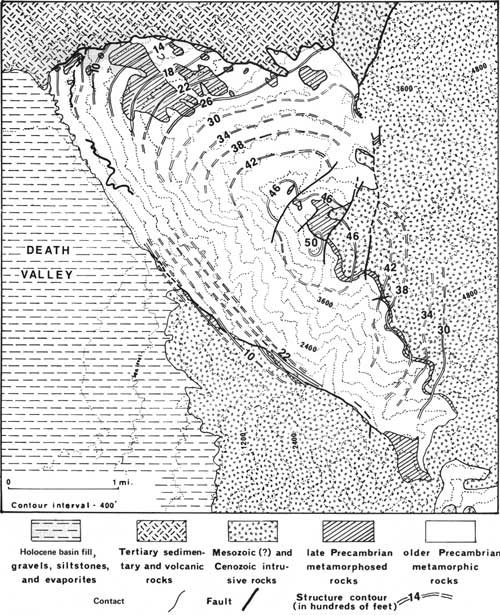
|
| Figure 2. Generalized geologic map of a part of the Black Mountains showing structural contours on contact between older Precambrian and later Precambrian units. (click on image for a PDF version) |
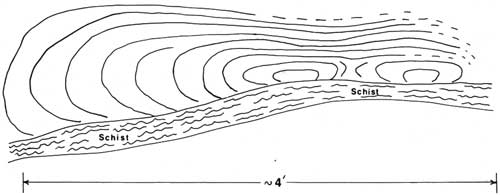
|
| Figure 3. Sketch of stromatolites in carbonate, Mormon Point. |
The older Precambrian rocks mapped in the Mormon Point area are also mantled by a sheath of carbonate-bearing rocks. The sequence preserved there is thicker than on the other dome and obscures most of the older Precambrian units. The exposures of carbonate-bearing rocks terminate, however, along a reverse fault on the south side of Shoestring Canyon (Fig. 1). Although there are extensive exposures of older Precambrian schist and gneiss south of this fault, no mantling carbonate-bearing sequence is exposed. The unconformity beneath the carbonate-bearing rocks is folded in the Mormon Point area, but the shape of that surface cannot be completely reconstructed. Minimum relief on the surface is 1,200 ft.
CORRELATION OF THE MARBLE WITH OTHER
CARBONATE UNITS OF THE REGION
If the diorite is Precambrian in age and is older than later Precambrian Pahrump Group and younger rocks that are extensively exposed in the southern part of the Black Mountains (Drewes, 1963), then the marble must be older than the Pahrump Group and composes a unit unexposed in the pre-Pahrump terrane of the Death Valley region.
If the diorite is Mesozoic in age, the marble may be correlated: (1) with carbonate units of the Pahrump, (2) with the Noonday Dolomite and (or) the Johnnie Formation, (3) with other carbonate units of later Precambrian or Paleozoic age, or (4) with carbonate units of Triassic age.
Correlation with the Noonday Dolomite or the Johnnie Formation is compatible with the paleogeographic reconstructions of Wright and Troxel (1966, 1967), with the lithologic descriptions of the Noonday by Williams and others (1974) and Williams (1974, personal communication) and with the lithologic descriptions of the Johnnie Formation by Benmore (1974). In Wright and Troxel's reconstructions, the Mormon Point and Copper Canyon—Sheep Canyon areas are part of the Nopah Upland, an area from which Pahrump Group sedimentary rocks were eroded in late Pahrump and pre-Noonday time. It is thought that parts of the Noonday Dolomite and the Johnnie Formation then transgressed and possibly blanketed the post-Pahrump terrane (Fig. 5). If so, then these carbonate units could be rocks of the Noonday Dolomite or the Johnnie Formation metamorphosed near the diorite body, if it is younger than the Noonday.
In general aspects, much of the carbonate sequence of Mormon Point resembles the shelf facies of the Noonday Dolomite described by Williams and others (1974). The massive carbonate rocks and the thinly-bedded carbonate rock with hornfels lenses may be the metamorphosed equivalent of massive domal carbonate units and thinly-bedded carbonate units with cryptalgal structures in the Noonday shelf facies. Moreover, sharp lateral thickness variations noted by Williams and others (1974) also occur in carbonate units at Mormon Point.
Parts of the sequence contain rocks similar to parts of the Johnnie Formation. This includes a ferroan dolomite and cyclic units consisting of clastic carbonate and fine-grained siliceous material. The clastic carbonate is cross-bedded (cross-beds 6 in. to 18 in. high) and exhibits a bimodal rosette that suggests a west-dipping paleoslope and a tidal environment.
Correlation with carbonate units in the Pahrump Group (possibly preserved as in Fig. 4), namely a carbonate member in the Crystal Spring Formation (Roberts, this volume) or with the overlying Beck Spring Dolomite also is a possibility, however, the marble of the Black Mountains is unlike the carbonate units of the Pahrump or any of the younger units in the late Precambrian, Paleozoic, and Mesozoic terranes of the Death Valley region.
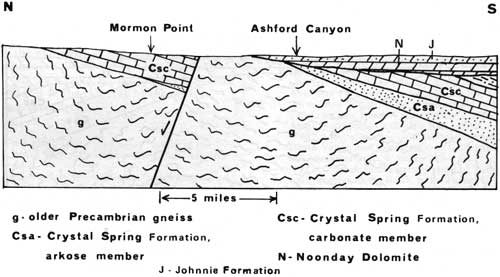
|
| Figure 4. Cross section of hypothetical late Johnnie Formation Black Mountain terrane showing preservation of carbonate member of Crystal Spring Formation adjacent to a fault. |

|
| Figure 5. Cross section of hypothetical late Johnnie Formation Black Mountain terrane showing onlap of Noonday Dolomite, in turn overlain by Johnnie Formation. |
DIORITE BODIES
The pluton or plutons of diorite that intrude the metamorphic rocks of the Copper Canyon—Sheep Canyon and Mormon Point—Smith Mountain areas extend discontinuously from the southwestern flank of Smith Mountain to Badwater, 6 mi north of the present map area, a distance of 15 mi (Drewes, 1963, Pl. 1). It comprises more than half the mapped crystalline rocks of the central Black Mountains. The original shape of the diorite pluton(s) is difficult to document because many of its contacts are faulted or are intrusive contacts with later granitic bodies. Near the Copper Canyon turtleback, however, the diorite occurs as a sill that follows closely the contact between the two units of metamorphic rocks (Fig. 6). In the area of Mormon Point, the intrusive relations are less simple.

|
| Figure 6. Cross section of ridge between Sheep Canyon and Copper Canyon showing diorite contact. |
Diorite contacts in the Copper Canyon—Sheep Canyon area are sharp and can be located within a few feet. Near Mormon Point the contacts are gradational over a few hundred to several hundred feet. Foliation in the older Precambrian gneiss becomes indistinct, and the gneiss commonly develops feldspar porphyroblasts near the diorite contact.
Xenoliths of metamorphic rocks in the diorite are common, particularly in a zone that extends southeast from the central part of Sheep Canyon into Gold Valley. The xenoliths consist mostly of the older Precambrian gneiss, but carbonate quartzite and schist form xenoliths on the north side of Gold Valley.
The petrology of the diorite, as described by Drewes (1963, p. 8-9), consists mostly of hornblende and plagioclase with minor or accessory proportions of biotite, clinopyroxene, sphene, titaniferous magnetite, and apatite. The texture is hypidiomorphic granular in most occurrences. In others, hornblende exhibits ophitic or poikilitic textures. Plagioclase is commonly poikilitic. Drewes stated that some of the hornblende may represent secondary growth from pyroxene and that some of the plagioclase may also be secondary. He added (1963, p. 9-10):
. . . This replacement is the chief metamorphic process that has affected the original diorite or gabbro; the metamorphism could have occurred at the same temperature and pressure as the metamorphism of the (older Precambrian) metasedimentary rocks.
The metadiorite is younger than the metasedimentary rocks, and it is possibly also younger than the folding of the metasedimentary rocks, for it is virtually unfoliated and it intrudes and appears to truncate the foliated rocks. In degree of metamorphism it has a far greater resemblance to the older Precambrian rocks of the Funeral Peak quadrangle than to the Pahrump series of late Precambrian age; therefore the metadiorite is tentatively assigned to early Precambrian.
The textures that Drewes attributed to metamorphism could also be ascribed to deuteric alteration of the intrusive body during cooling. Reliable radiometric dates have yet to be obtained for the diorite. However, it resembles diorite that is clearly Mesozoic in age in other bodies in the Death Valley region. These occur in the Avawatz Mountains (B. W. Troxel and L. A. Wright, personal commun.) and the southern part of the Panamint Range (Johnson, 1957). A post-Precambrian age for the diorite is also suggested by the observation that it extends south into an area where the Precambrian gneiss is cut by numerous diabase dikes that were emplaced in Pahrump time. The diorite there is not intruded by diabase, although none of the diorite contacts has been observed to actually show crosscutting relationships with the diabase. Moreover, unlike the metasedimentary units, the diorite is devoid of pervasive foliation. That it postdates the folding of the metasedimentary rocks is indicated by mafic dikes that extend into the folded rocks from the pluton(s) of diorite, without evidence of folding. The diorite crosscuts faults which, in turn, cut exposures of the folded carbonate sequence. Thus, the diorite is believed to represent a much later event related to the Mesozoic plutonism so common in the region west and south of Death Valley.
SILICIC PLUTONS AND DIKES
The igneous bodies that intrude the diorite and the metasedimentary units range in composition from granite to monzonite. The mappable igneous bodies comprise a pink porphyritic granite, two types of quartz monzonite, three types of porphyritic quartz monzonite or latite, red porphyritic rhyolite, and andesite dikes.
To completely reconstruct the sequence of intrusive events through cross-cutting relationships is difficult. The pink porphyritic granite and the porphyritic quartz monzonite intrude the diorite but not each other. A gray phase of the quartz monzonite clearly intrudes the pink porphyritic granite, as demonstrated by xenoliths of the latter in the monzonite. A white phase of the quartz monzonite intrudes the diorite, but its contact with the porphyritic quartz monzonite north of Sheep Canyon is unexposed.
The red porphyritic rhyolite that forms plugs and the andesite that occurs as dikes probably represent the latest events. The andesite dikes are abundant on the south side of Gold Valley and Smith Mountain where they intrude the gray phase of the quartz monzonite. One andesitic plug intrudes the porphyritic quartz monzonite near the northeastern corner of the area. The red porphyritic rhyolite intrudes both the porphyritic quartz monzonite and the quartz monzonite at various localities.
The intrusive contacts between these various igneous bodies and their host rocks are commonly gradational over distances of hundreds of feet or more (Fig. 7).
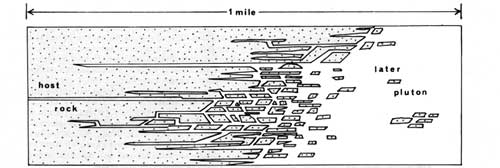
|
| Figure 7. Schematic cross section of gradational contact between silicic plutons and host rock. |
The larger plutons commonly are bordered by an outer zone where only a few dikes penetrate the host rock, an intermediate zone where the number of dikes increases to form an anastomosing network in which the host rock "floats" as xenoliths, and finally an inner zone where the number, size, and volume of xenoliths approaches zero. The anastomosing dikes are largely horizontal, and xenoliths commonly maintain a tabular, subhorizontal dimensional orientation. On the other hand, many contacts are sharp. The pink porphyritic granite exhibits a sharp subhorizontal contact with the older Precambrian rocks on the southwestern flank of Smith Mountain.
Dike swarms and dike systems that are compositionally related to the silicic plutons extend beyond the margins of those intrusive bodies. Many of the dike systems show no systematic orientation, while others show a strong preferred orientation. One system of dikes occupies the crest of a ridge that lies between Sheep Canyon and Copper Canyon. This dike system consists of gray porphyritic quartz monzonite similar to one of the porphyritic intrusive phases a few miles to the east. The dikes are remarkably planar; they are all subvertical, and all but two strike approximately N. 30° E. They are spaced 200 to 800 yd apart, and their thicknesses reach 75 ft and lengths over 2 mi. This planarly oriented system of dikes is restricted to the older Precambrian rocks of the ridge. The dikes terminate to the southwest against the range front fault and to the northeast against the turtleback fault. Some of the dikes cross the intrusive contact into the diorite, but where they do, they change orientation.
A second system of dikes occupies the northerly and northwesterly faces of a ridge of diorite just to the south of the mouth of Sheep Canyon. Dikes in this system are essentially planar but interfinger more than the dikes of the previously described system. They strike N. 75° E. and dip 35° to 45° to the southeast. These dikes also consist of porphyritic quartz monzonite. They are more closely spaced than the other system—as close as 100 ft or less.
Most of the silicic dikes and all of the silicic plutons of the region lack a visible foliation. One swarm of dikes, composed of gray aphanitic to slightly porphyritic rock, shows well-developed layering. Layers are distinguished by varying shades of gray, or gray and reddish gray. Layer thickness varies from a few millimeters to a few centimeters. The layering is interpreted as flow layering because isoclinal folds symmetric with dike margins are common in the layers. In larger dikes, the central portions commonly are unlayered.
The age of these igneous bodies is uncertain. Drewes (1963) reported two lead-alpha age determinations on zircon in the monzonitic rocks 45 ± 10 and 30 ± 10 m.y. These determinations, made in 1959, are probably too old by a large factor (Rose and Stern, 1960). Fleck (1970) reported K-Ar whole-rock age dates on the older volcanic rocks of the region of 6 to 8 m.y. Because these units were deposited on or were involved in faulting that cuts the monzonitic rocks, these dates probably can be considered a minimum age for the monzonites. The time of intrusion for these rocks seems best placed between 10 and 15 m.y. ago.
TERTIARY AND QUATERNARY SEDIMENTARY AND VOLCANIC
ROCKS
Drewes (1963) described in detail the lithology of the Tertiary and Quaternary rocks of the region, the older volcanic rocks, the Copper Canyon Formation, the Funeral Formation and gravel of various ages. The older volcanic rocks include rhyolite and rhyodacite flows and tuff with interbedded tuff breccia and agglomerate and minor volcanigenic sediments. The Copper Canyon Formation comprises over 10,000 ft of reddish conglomerate, yellowish-gray siltstone, and evaporites and intercalated basalt. Based on mammalian fossils, it is thought to be Pliocene in age (Curry, 1941). The Funeral Formation consists of tan conglomerate and diorite megabreccia.
STRUCTURAL FEATURES
The structural features of the central Black Mountains appear to have developed in two or more stages. The latest stage has produced faults which are compatible with a northwesterly crustal extension of the Black Mountains—central Death Valley terrane. The earliest stages involved the development of the major structural features of the crystalline terrane before extension began. This earlier deformation and intrusion resulted in a tectonic fabric that controlled the faulting during the northwest crustal extension of the later stage. The silicic plutons may mark the beginning of the extensional stage.
The features of the latest stage include many northeast-trending intermediate to high-angle normal faults with displacements generally within the range of a few tens of feet to a few hundred feet. The features of the latest stage mainly consist of faults that are either clearly normal or seem best interpreted as normal in sense of movement. The most abundant of the well-defined normal faults strike northeast and ordinarily show displacements measurable in tens or hundreds of feet; some of the displacements are 1,000 ft or more. One of the larger of the northeast-trending faults bounds the western side of the depression that contains the Copper Canyon Formation (Fig. 1). The faults that derive their configuration from earlier structural features and that are also interpreted here as being normal include the turtleback faults at Mormon Point and Copper Canyon and extensions of the turtleback faults. Linear features, including slickensides, fault mullions, and drag folds, on the surfaces of these faults indicate that the downward movement of the hanging wall has been in a northwesterly direction.
Apparently related to the normal faults are two high-angle faults that strike northwest and can be traced for 5 mi or more (Fig. 1). The linear features of movement on the planes of these faults indicate movements in a normal sense and also in a right-lateral oblique-slip sense. One of these faults terminates along strike in the lower part of Sheep Canyon.
The nature and distribution of the faults of the Black Mountains escarpment support the long-held view that the Black Mountains front is essentially an irregular fault scarp developed during the latest stage of deformation. It consists of northwest-trending en echelon faults with linking northeasterly irregular zones. The irregular zones, however, contrary to previously expressed interpretations, are also related to crustal extension. They coincide geometrically with weak horizons (the carbonate-bearing units) in the early fabric of the crystalline rocks. This suggests that the orientation and position of these zones was controlled by zones of weakness in the inherited fabric.
This view of the Black Mountains front has recently been expressed by Wright and others (1974, reprinted in this volume) and is compatible with the pull-apart model (Fig. 8A) for the origin of the central segment of Death Valley (Burchfiel and Stewart, 1966). Figure 8B is a modification of that model and shows the structural features of the east wall of the central part of Death Valley in greater detail.
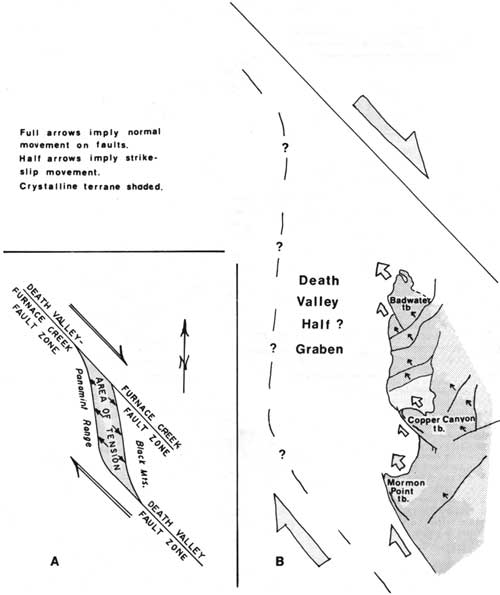
|
| Figure 8. A. Diagrammatic map showing interpretation of strike-slip movement and area of tension (from Burchfiel and Stewart, 1966). B. Detailed map of east wall of area of tension (generalized from Death Valley sheet, Geologic Map of California). |
REFERENCES CITED
Burchfiel, B. C., and Stewart, J. H., 1966, "Pull-apart" origin of the central segment of Death Valley, California: Geol. Soc. America Bull., v. 77, p. 439-442.
Curry, H. D., 1941, Mammalian and avian ichnites in Death Valley [abs.]: Geol. Soc. America Bull., v. 52, no. 12, p. 1979.
______ 1954, Turtlebacks in the central Black Mountains, Death Valley, California, in Jahns, R. H., ed., Geology of southern California: California Div. Mines and Geology Bull. 170, chap. IV, contr. 7.
Drewes, H., 1959, Turtleback faults of Death Valley, California: A reinterpretation: Geol. Soc. America Bull., v. 70, p. 1497-1508.
______ 1963, Geology of the Funeral Peak quadrangle, California, on the east flank of Death Valley: U.S. Geol. Survey Prof. Paper 413, 78 p.
Eskola, P. E., 1949, The problem of mantled gneiss domes: Geol. Soc. London Quart. Jour., v. 104, p. 461-476.
Fleck, R. J., 1970, Age and tectonic significance of volcanic rocks, Death Valley area, California: Geol. Soc. America Bull., v. 81, p. 2807-2816.
Johnson, B., 1957, Geology of a part of the Manly Peak quadrangle, southern Panamint Range, California: Calif. Univ. Pubs. Geol. Sci., v. 30, no. 5, p. iv, 353-423.
Noble, L. E., 1941, Structural features of the Virgin Spring area, Death Valley, California: Geol. Soc. America Bull., v. 52, p. 941-1000.
Noble, L. F., and Wright, L. A., 1954, Geology of the central and southern Death Valley region, California, in Jahns, R. H., ed., Geology of southern California: California Div. Mines and Geology Bull. 170, chap. II, contr. 4.
Rose, H. J., Jr., and Stern, T. W., 1960, Spectrochemical determination of lead in zircon for lead-alpha age measurements: Am. Mineralogist, v. 45, p. 1243-1256.
Williams, E. G., Wright, L. A., and Troxel, B. W., 1974, Depositional environments of the late Precambrian Noonday Dolomite, southern Death Valley region, California: Geol. Soc. America, Abs. with Programs (Cordilleran Sec.), v. 6, no. 3, p. 276.
Wright, L. A., and Troxel, B. W., 1966, Strata of late Precambrian-Cambrian age, Death Valley region, California-Nevada: Am. Assoc. Petroleum Geologists Bull., v. 50, no. 5, p. 846-857.
______ 1967, Limitations on right-lateral, strike-slip displacement, Death Valley and Furnace Creek fault zones, California: Geol. Soc. America Bull., v. 78, p. 733-750.
______ 1973, Shallow-fault interpretation of Basin and Range structure, southwestern Great Basin, in De Joong, R., and Scholten, R., eds., Gravity and tectonics: Amsterdam, Elsevier Pub. Co.
Wright, L. A., Otton, J. K., and Troxel, B. W., 1974, Turtleback surfaces of Death Valley viewed as phenomena of extensional tectonics: Geology, v. 2, no. 2, p. 53-54.
This research was supported by NSF Grant GA—16119, The Geological Society of America, the P. D. Krynine Memorial Fund at Pennsylvania State University, and the Death Valley Natural History Association.
| <<< Previous | <<< Contents >>> | Next >>> |
state/ca/cdmg-sr-106/sec5.htm
Last Updated: 24-Jul-2009